You can press [Previous Settings] to recall the settings used to send scanned data in the past. The sending destination is also applied together with the settings that are called up.
When you call up the setting history, the specified destination and scan settings are overwritten.
Using Internet Fax (I-Fax)
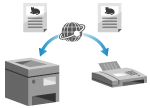
Internet Fax (I-Fax) is a function for sending and receiving faxes via the Internet.
Since faxes are sent without using a telephone line, you can lower your communication costs. When you receive an I-Fax, the received data is printed automatically.
The machines for sending and receiving I-Faxes must support I-Fax technology.
Since faxes are sent without using a telephone line, you can lower your communication costs. When you receive an I-Fax, the received data is printed automatically.
The machines for sending and receiving I-Faxes must support I-Fax technology.
NOTE
Standards for I-Fax are defined by ITU-T (International Telecommunication Union - Telecommunication Standardization Sector). You can send and receive I-Faxes to and from the machine of another manufacturer, as long as that machine is ITU-T compliant.
The imageFORCE series is compliant with Recommendation T.37 (Procedures for the transfer of facsimile data via store-and-forward on the Internet).
The imageFORCE series is compliant with Recommendation T.37 (Procedures for the transfer of facsimile data via store-and-forward on the Internet).
Sending I-Faxes
You can scan an original and send the scanned data by I-Fax.
Scanned data is sent by e-mail as an attached TIFF file. Just like when you send a regular e-mail, you can add a subject and message and specify multiple destinations.
Scanned data is sent by e-mail as an attached TIFF file. Just like when you send a regular e-mail, you can add a subject and message and specify multiple destinations.
Required Preparations
On the machine, configure the settings of the e-mail server to be used to send I-Faxes. Configuring Information of the E-mail Server
1
Place the original. Placing Originals
If the screen for selecting the thickness of the original appears, select the thickness of the placed original.
2
On the control panel, press [Scan and Send] in the [Home] screen. [Home] Screen
The scan screen is displayed.
3
Specify the destination. Specifying Destinations
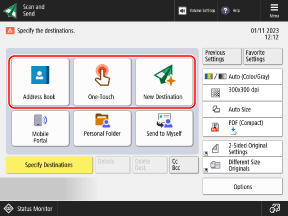
4
Configure the scan settings. Scan Settings
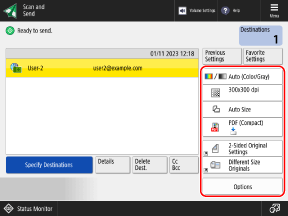
When "Favorite Settings" are registered, you can call them up by pressing [Favorite Settings]. Registering and Recalling Favorite Settings
When Recalling Previous Settings (Setting History)

* You cannot use the setting history when destinations are managed with access numbers. Hiding Destinations (Access Number Management)
On the [Previous Settings] screen, select the history you want to recall, and press [OK].
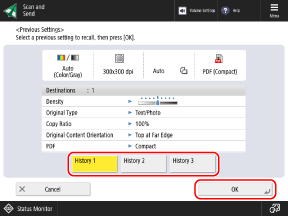
You can change the called up destination and scan settings before sending.
Each login user can select from their own setting history.
Guest users or users who are not logged in can select from the setting history common to unauthorized users.
Guest users or users who are not logged in can select from the setting history common to unauthorized users.
When entry of new destinations is restricted, the setting history is cleared regardless of the type of restricted destination. Sending Only to Registered Destinations
5
Press [ Start].
Start].
 Start].
Start].The machine starts scanning the original.
To cancel scanning, press [Cancel]  [Yes]. Canceling Scanning
[Yes]. Canceling Scanning
 [Yes]. Canceling Scanning
[Yes]. Canceling ScanningWhen scanning of the original is completed, the scanned data is sent. You can use [ Status Monitor] to check the sending status and log. Checking the Send or Save Status and Log of Scanned Data
Status Monitor] to check the sending status and log. Checking the Send or Save Status and Log of Scanned Data
 Status Monitor] to check the sending status and log. Checking the Send or Save Status and Log of Scanned Data
Status Monitor] to check the sending status and log. Checking the Send or Save Status and Log of Scanned DataWhen [Press the [Start] key to scan the next original.] Is Displayed

When an original is placed on the platen glass and scanned, or when scanning is performed using Job Build, the screen for scanning additional originals is displayed.
1
To continue scanning originals, place the next original, and press [ Start].
Start].
 Start].
Start].The next original is scanned, and the same screen is displayed.
Repeat this process until scanning of all originals is completed.
Repeat this process until scanning of all originals is completed.
When placing originals in the feeder to scan, remove the scanned original (original ejected to the original output tray) before placing the next original.
When Changing the Scan Settings for Each Original
On the screen with the displayed message, press [Change Settings]. You can change the following settings:
[Select Color]
[Scan Size]
[Copy Ratio]
[2-Sided Original]
[Density]
[Original Type]
For example, when scanning a 2-sided original after scanning a 1-sided original, press [Change Settings], and set [2-Sided Original].
2
Press [Start Sending].
The scanned data is sent.
When the Screen for Entering and Confirming the User Name and Password Is Displayed
Enter and confirm the user name and password while following the instructions on the screen.
When [To Status Monitor] Is Displayed

To check the sending status and log, press [To Status Monitor]. Checking the Send or Save Status and Log of Scanned Data
Press [Close] to return to the scan screen.
Press [Close] to return to the scan screen.
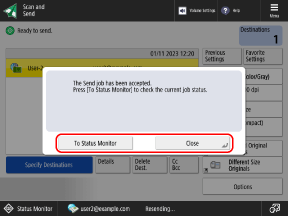
NOTE
When Multiple Originals Are Fed during Scanning and Operations Are Canceled (Detect Multiple Sheet Feed)
A message appears on the screen. Remove the jammed original while following the instructions in the message. Paper and Staple Jams
When the jammed original is removed, the screen for resuming operations is displayed.
If multi sheet feeding was detected incorrectly, press [Do Not Detect Multi. Sheet Feed] to resume scanning.
When the jammed original is removed, the screen for resuming operations is displayed.
If multi sheet feeding was detected incorrectly, press [Do Not Detect Multi. Sheet Feed] to resume scanning.
To prevent detection of multi sheet feeding, configure either of the following settings:
On the scan screen, press [Options]  [Detect Feeder Multi Sheet Fd.] each time you scan, to cancel detection of multi sheet feeding.
[Detect Feeder Multi Sheet Fd.] each time you scan, to cancel detection of multi sheet feeding.
 [Detect Feeder Multi Sheet Fd.] each time you scan, to cancel detection of multi sheet feeding.
[Detect Feeder Multi Sheet Fd.] each time you scan, to cancel detection of multi sheet feeding.Change the default settings to prevent detection of multi sheet feeding. [Set Detection of Feeder Multi. Sheet Feed as Default]
* Depending on the model, the optional document feeder double feeding detection kit may be required in order to use the multiple sheet feed detection function. 



Previewing Content Before Sending
You can display a preview screen to check the content before sending scanned data. You can also change the page order and delete pages on the preview screen. Checking the Scanned Data and Organizing Pages (Preview)
Improving the Quality of the Sent Image
If the sent images are too dark or the light colors in the background of the originals cannot be removed, you may be able to improve the quality by configuring the following settings before sending:
Set [Black & White] as the color for scanning. Selecting a Color
Set the resolution to [200x400 dpi], [300x300 dpi], [400x400 dpi], or [600x600 dpi]. Setting the Resolution
Set the original type to [Text]. Selecting the Original Type
Set the background density to [Auto]. Adjusting the Density
* In the [Settings/Registration] menu, if [Fax/I-Fax Send Jobs] in [Speed/Image Quality Priority for B&W Scan] is set to [Speed Priority], change the setting to [Quality Priority]. [Speed/Image Quality Priority for B&W Scan]
([Quality Priority] is set by default.)
([Quality Priority] is set by default.)
Receiving I-Faxes
The machine automatically receives I-Faxes from the configured e-mail server, so you do not need to perform operations to receive them.
When an I-Fax is received, the Processing/Data indicator on the control panel blinks green, and the machine automatically prints the I-Fax on the same size of paper as the received data. If the same size of paper is not loaded, the received I-Fax is printed on another size of paper.
You can also change the print settings, such as 2-sided printing and the rules for printing on another size of paper. Changing the Print Settings for Received Faxes
When an I-Fax is received, the Processing/Data indicator on the control panel blinks green, and the machine automatically prints the I-Fax on the same size of paper as the received data. If the same size of paper is not loaded, the received I-Fax is printed on another size of paper.
You can also change the print settings, such as 2-sided printing and the rules for printing on another size of paper. Changing the Print Settings for Received Faxes
Required Preparations
On the machine, configure the settings of the e-mail server to be used to receive I-Faxes. Configuring Information of the E-mail Server
Manually Receiving I-Faxes
If you want to connect to the server before receiving I-Faxes automatically, or if the machine is set to not receive I-Faxes automatically, you can receive I-Faxes manually.
1
On the control panel, press [ Status Monitor] in the [Home] screen or other screen. [Home] Screen
Status Monitor] in the [Home] screen or other screen. [Home] Screen
 Status Monitor] in the [Home] screen or other screen. [Home] Screen
Status Monitor] in the [Home] screen or other screen. [Home] ScreenThe [Status Monitor] screen is displayed.
2
Press [Receive]  [Job Log].
[Job Log].
 [Job Log].
[Job Log].3
Press [Check I-Fax RX].
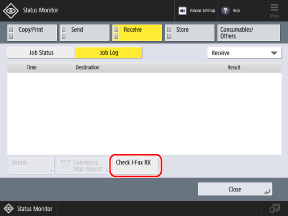
The machine connects to the server. When you receive an I-Fax, printing starts automatically.
If [Check I-Fax RX] is not displayed, select [Receive] in the pulldown menu at the top right of the screen.
NOTE
When an I-Fax Is Not Received or Printed
Check the status of the machine. Cannot Receive a Fax
When an error or other problem occurs with the machine and the received I-Fax cannot be printed, you can forward the received I-Fax to the Memory RX Inbox. [Forward Temporarily Stored File to Memory RX Inbox]
Checking Received I-Faxes with Divided Data
You can check the status of received I-Faxes that were divided into multiple parts when they were sent.
Press [Fax/I-Fax Inbox] on the [Home] screen  [Memory RX Inbox]
[Memory RX Inbox]  [Divided Data RX Inbox]
[Divided Data RX Inbox]
 [Memory RX Inbox]
[Memory RX Inbox]  [Divided Data RX Inbox]
[Divided Data RX Inbox]You can select an I-Fax and press [Divided Data List] to check the list of divided data for the I-Fax.
To delete I-Fax data (the divided data for an I-Fax), select an I-Fax and press [Delete]  [Yes].
[Yes].
When [Print When Deleted] is set, the machine prints the divided data when you delete it.
 [Yes].
[Yes]. When [Print When Deleted] is set, the machine prints the divided data when you delete it.
For cases in which the divided I-Fax data is only partially received, you can set the amount of time to wait until the reception of the remaining divided data is canceled. [Divided Data RX Timeout]